Blackfriars Bridge: The solving of a 'Victorian jigsaw puzzle'
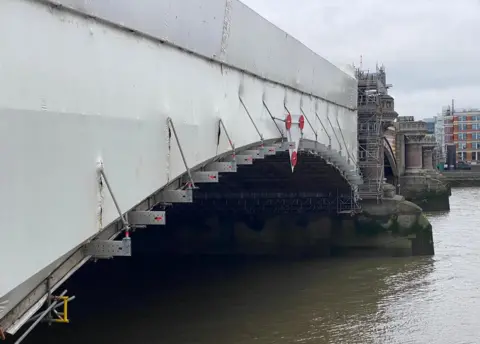 BBC
BBCFor more than a year, large parts of the 290m-long (950ft) Blackfriars Bridge in central London have been shrouded by scaffolding and thick layers of wrapping.
With work not due to end until summer next year and at an estimated cost of £15m, it may look like a huge redevelopment is taking place on the 153-year-old crossing, but the project is actually only considered routine maintenance.
Yet that does not mean it is an easy task.
"It's a really challenging job," explains Tom Creed, group engineer with the City of London. "It's like a Victorian jigsaw puzzle that we've slowly taken to pieces."
Blackfriars Bridge was last given a touch-up in 2000 but since then the dark red colour has become a pale pink, rust has stained large parts and more than 100 of the 2,168 balusters - the small upright columns which make up the balustrades (or handrails) - need to be replaced.
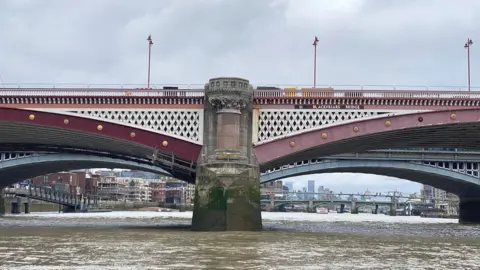 BBC
BBC"Only when we actually take it apart do we actually understand how it was put together and the problems that we're facing in terms of restoration," the group engineer says.
Those who regularly cross the bridge may simply dismiss it simply as a way into the City, but look closely at the structure and you can see touches of Victoriana throughout in the form of its elaborate - yet also barely noticeable - decoration.
The tops of the thick stone piers marking the end of each of the five spans (or arches) that make up the crossing were designed to look like pulpits to reflect the Blackfriars Monastery that once stood on the banks of the Thames, and from which the bridge takes its name.
 BBC
BBCBeneath these are numerous intricately carved birds with each of the eight piers having a different species specially chosen for every spot.
Those gazing upriver are freshwater birds like herons, while staring the other way are seabirds - because it was once thought the bridge marked the point where the river became the sea.
Even the bases of the piers have a purpose, with the same designs being carefully carved on them as on the bottoms of the balusters. This is in spite of their position by the water meaning they are only really ever seen by any birdlife that might decide to perch upon them.
Yet it appears the Victorian creators didn't always follow such logic with their designs, or at least if they did they failed to let anyone know.
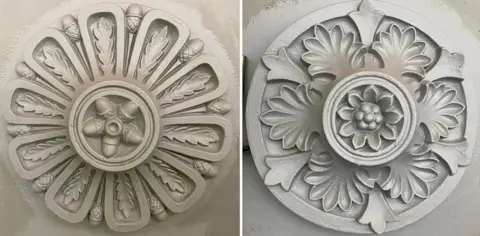 BBC
BBCAlong the sides of the bridge sit dozens of rosettes which will all be blasted clean and delicately decorated in a shade of gold on a black background.
There are six different designs in all - one is made up of acorns and oak leaves, another has flowers - but for a bridge that seems filled with meaning nobody is quite sure of the reason for these designs.
"It's brilliant detail but we don't know why, but that's what makes the bridge," Mr Creed says.
 BBC
BBCSimilarly, the 2,168 cast-iron balusters may look alike but there are actually nine different designs and seemingly placed at random, meaning each one has to be numbered and tagged before being taken apart, removed and taken off site.
They are then either cleaned and repainted or recast and finally returned to the exact same spots they were placed in in the 1860s.
As such, the engineering team is treating the Grade II-listed bridge "like a museum piece", says Mr Creed.
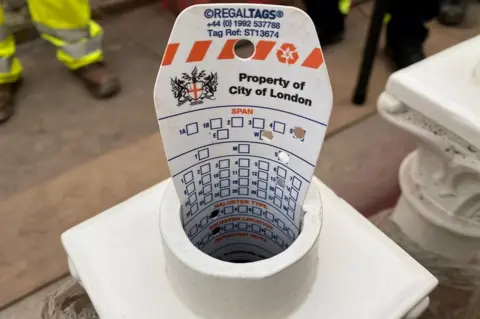 BBC
BBCThe current bridge is the second crossing to have been built here. The first was created between 1760 and 1769 but demolished the following century due to damage caused by erosion to its stonework.
Designed by civil engineer Joseph Cubitt, the current crossing was opened on 6 November 1869 by Queen Victoria, who was clearly having a busy day of bridge-opening that day as she headed up Farringdon Road straight after to open the Holborn Viaduct.
The historical link between the two bridges has been maintained in the deep red hue which will coat Blackfriars - the same colour used on the viaduct.
Nevertheless, the crossing has not always been that tone, with it starting off green before becoming a light blue-grey in the 1980s, and finally red in the 1990s.
It is also wider than when it was first built, extra road space having been added in 1909 predominately to allow space for trams to trundle over it.
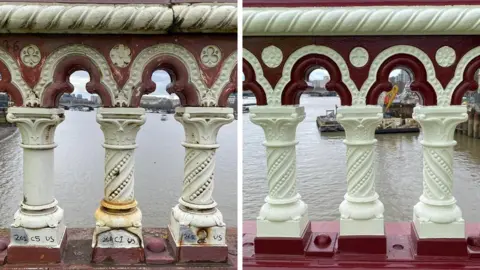 BBC
BBCWhile the high cost of such repair work has been a big problem for other London crossings like Hammersmith Bridge, a historical quirk means Blackfriars - like four other crossings in the City - doesn't have the same issue.
"One of the things that so few people in London know, even Londoners themselves, is that these bridges are not state assets, they're privately owned," explains Giles Shilson, chair of the Bridge House Estates board.
Blackfriars, Tower, Southwark, Millennium and London Bridge are all owned by the Bridge House Estates charity, which was set up in the late 11th Century as a way to maintain the city's first crossing, London Bridge.
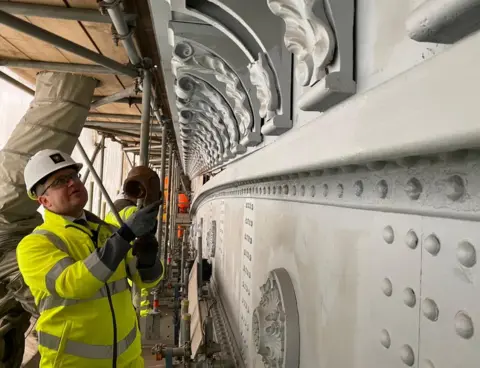 BBC
BBC"People used to give taxes and tolls and rents, and even bequests in their wills for the upkeep of London Bridge," says Mr Shilson.
"Over the past 950 years, with some careful stewardship and compound interest, we now are able to maintain and support all five of those bridges at no cost to the taxpayer."
He describes the work as "hugely important" on what he describes as "the major arteries that enable the more than half a million Londoners to get into and out of the City each day".
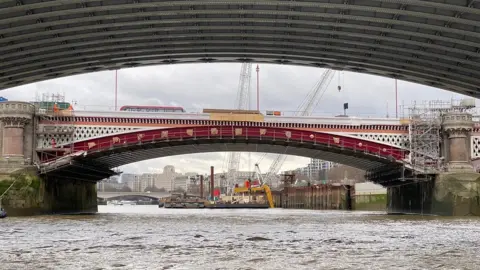 BBC
BBCIt is hoped another such refurbishment will not be required for as long as 25 years, but the structure itself is expected to last a while longer than that.
"We're using the same techniques that they used when the Victorians built it and we're really hoping that this will keep it going for another 150 years," says Mr Creed.
"Hopefully, it'll serve London for many years to come."

A bridge into the City
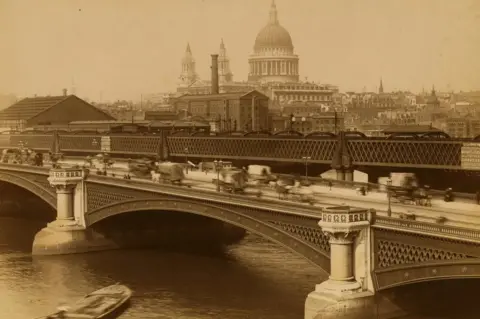 Getty Images
Getty Images- Blackfriars Bridge was first known as Pitt Bridge after William Pitt the Elder, who was prime minister from 1766 until 1768
- It was the third bridge to be built in central London after London Bridge and Westminster Bridge
- The tollbooths that originally stood on the crossing were destroyed during the Gordon Riots in 1780, when London's most destructive protests led to widespread damage to property and the deaths of hundreds of rioters
- The bridge stands above where the underground River Fleet enters the Thames
- Roberto Calvi, who was known as "God's banker", was found hanging from scaffolding under Blackfriars Bridge in 1982 - initially it was believed he had taken his own life but 20 years later forensic investigators declared he had actually been murdered
- On average about 15,500 motor vehicles crossed the bridge each day in 2021, according to government figures
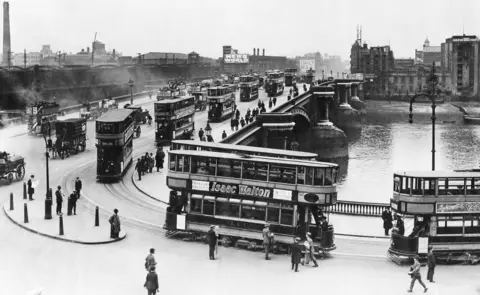 Getty Images
Getty ImagesAll images subject to copyright

Follow BBC London on Facebook, Twitter and Instagram. Send your story ideas to [email protected]
